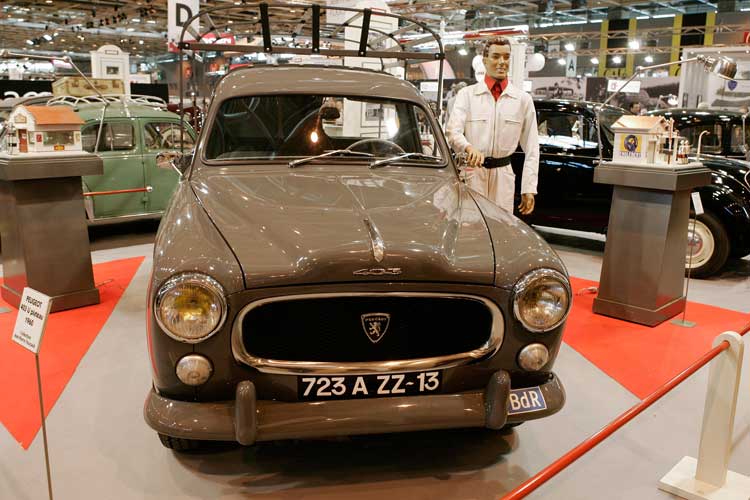Peugeot 403
The 403, launched half a century ago, established Peugeot as a global brand. By Andrew Roberts

The time: a weekday afternoon. The television channel: Five. The scene: a murder somewhere in the Universal Studio backlot. Suddenly, amid the black and white Dodge Polara police cruisers materialises a battered convertible driven by someone who appears to have covered themselves in glue prior to dashing through the nearest charity shop. It is Det Lt Columbo en route to arrest Stewart Granger with a dyed-orange face, or an equally villainous elderly film star of similar note.
It is a television moment that never fails to cause mass wincing in Peugeot owners everywhere, for the lieutenant's car is none other than one of only 504 1959 Peugeot 403 Cabriolets. In its heyday, the Cabriolet was Peugeot's range-topper, with its leather trim, fog lamps, and cigarette lighter. In the US, the 403 saloon was proudly marketed as having "no fins, no excessive trim, no strange shapes" and as being one of the "seven best-built cars in the world". For once, the copy was more than mere hyperbole.
Peugeot embarked on the 403 project in 1950 with a design rationale to produce a car that would supplant, and eventually replace, their popular 1948 1.3-litre 203 saloon and appeal to the re-emerging French middle-class sector. Peugeot believed small cars meant small profits, and that the swingeing taxation on large-engine cars would result in limited sales. What the traditional Peugeot customer apparently needed was a sizeable six-seater saloon powered by a relatively small 1.5-litre engine, a vehicle that would be robust enough for the roads of Francophone Africa and smart enough for Parisian arrondissements.
However the original in-house designs of Henri Thomas were deemed too similar to the Franco-American lines of the likes of the Ford Vedette and other voitures des nouveaux riches and so, in 1951, Battista Farina of Turin was commissioned to style project 403. The result was a solid but elegantly understated saloon that would hopefully inject a note of Gallic (or at least Gallic-Italian) dignity on to roads that were already becoming populated with Antwerp-assembled Plymouths – the car of choice of many a French B-film gangster.
The new 403 was not exactly designed for speed – its 1.5-litre engine gave a mere 65bhp at 5,000rpm – but its combination of a solid rear axle and simple suspension meant for a robust constitution. As befitting a car for the respectable bourgeoisie, the 403 was pleasantly equipped as standard with a sliding roof, folding armrests and separate reclining front seats. A column-mounted gear-lever made the 403 a genuine six-seater; albeit with the sixth occupant being obliged to perch somewhat precariously between the driver and front passenger.
When it was launched, on 20 April 1955, its success was such that by the end of that year its second-hand value was higher than its selling price. Part of the 403's appeal in France was due to the fact that it occupied its own niche in the market; the Simca Aronde was much smaller, the Simca Vedette and Renault Frégate were far larger and more expensive – as was the other new French car of 1955, the Citroë* DS, while the 1.9-litre Traction Avant Onze Légère was coming to the end of its long run.
The 403 was to eschew the tail-fins of Simca and the avant-garde approach of Citroë* in favour of low-key sobriety that made it an iconic police car of its era, its 80mph top speed being more than compensated for by the fact that the 403 could apparently take any amount of abuse and, with drum brakes fitted to all wheels, you probably wouldn't wish to travel any faster.
Sweden and West Germany provided the 403 with its chief rivals – the Volvo 122 Amazon and the Mercedes-Benz 180 Ponton. All three were slightly underpowered four-cylinder saloons, all bore a hallmark of quality and all were available with a dashing white steering wheel. And unlike contemporary British offerings such as the Morris Oxford and the Humber Hawk, these continental upstarts placed an emphasis on practicality as opposed to leather, walnut, and carpets.
Right-hand-drive 403s are unusual as the UK's high-import duties in the 1950s and 1960s made the Peugeot more expensive than a Cresta or Zodiac but many Commonwealth countries responded to the 403's durability and comfort.
Peugeot's approach to the 403's development was exemplified by continual improvements rather than annual facelifts, with the eight-seater Familiale Estate in 1957 and a diesel engine in 1959 increasing the 403's appeal to African and South American buyers. In 1960, the millionth 403 left the production line and Peugeot introduced the stripped-spec 7CV saloon for the taxi market but, by this point, the 403 had been supplanted by the 404. Here was a new Peugeot that went so far as to feature vestigial tail-fins. But 403 production continued until 1966, by which time it was nicknamed l'increvable – the indestructible.
In the UK, the general public only seems to recognise it from re-runs of The Day of The Jackal, plus a certain US TV series concerning America's most unlikely detective, but in its homeland the 403 remains an automotive icon – the car that established the Peugeot marque as a global brand.
Subscribe to Independent Premium to bookmark this article
Want to bookmark your favourite articles and stories to read or reference later? Start your Independent Premium subscription today.

Join our commenting forum
Join thought-provoking conversations, follow other Independent readers and see their replies